

ORC On > 3-5. Students in grades 3–5 may be interested in exploring some foundational information about earthquakes and tsunamis, changes in the Earth's surface brought about by fault activity, or interesting and unusual bits of information about earthquakes.
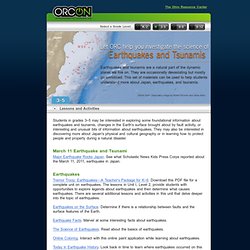
They may also be interested in discovering more about Japan's physical and cultural geography or in learning how to protect people and property during a natural disaster. Tremor Troop: Earthquakes—A Teacher's Package for K–6. Download this PDF file for a complete unit on earthquakes. ORC On. Virtual School House/Projects/the Bridge Project/Story Page 2. The process of constructing the bridges required meticulous work by a team of students--who only had pasta to work with!

The Bridge Model The second component of the Bridge Project was the construction of a bridge model. Students organized themselves into groups of three or four. Ms. New-tritional Info « Mathalicious. BIEPBL. Collaborative project-based learning and problem-based learning in higher education: a consideration of tutor and student roles in learner-focused strategies. Printer friendly version in PDF KEYWORDS: Collaborative Project-based Learning, Problem-based Learning, Facilitation.
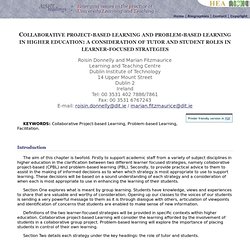
Introduction. Project Based Learning Language Arts Projects. Project-based learning. Project-based learning (PBL) is considered an alternative to paper-based, rote memorization, teacher-led classrooms.

Proponents of project-based learning cite numerous benefits to the implementation of these strategies in the classroom including a greater depth of understanding of concepts, broader knowledge base, improved communication and interpersonal/social skills, enhanced leadership skills, increased creativity, and improved writing skills. John Dewey initially promoted the idea of "learning by doing. " John Dewey, 1902 Markham (2011) describes project-based learning (PBL) as: " PBL integrates knowing and doing.
Students learn knowledge and elements of the core curriculum, but also apply what they know to solve authentic problems and produce results that matter. Project-based learning has been associated with the "situated learning" perspective of James G. Structure[edit] Elements[edit] Olander School for Project Based Learning  Meridian: Getting A Grip On Project-Based Learning. Museum Box Homepage. Life in a 21st-Century English Class. Teaching Strategies Creating a Common Craft-style video is part of the classroom assignment.
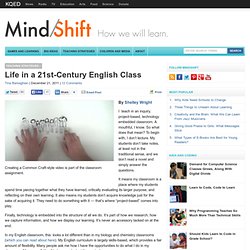
By Shelley Wright I teach in an inquiry, project-based, technology embedded classroom. A mouthful, I know. So what does that mean? It means my classroom is a place where my students spend time piecing together what they have learned, critically evaluating its larger purpose, and reflecting on their own learning. Finally, technology is embedded into the structure of all we do. In my English classroom, this looks a lot different than in my biology and chemistry classrooms (which you can read about here). My curriculum states that I need to develop skills in 5 areas: reading, writing, viewing and representing, listening and speaking. Whenever we begin a new inquiry unit, research is always involved. After researching, we come back together to discuss what needs to happen next. This semester, we’ve chosen to create a social media campaign to raise awareness around modern slavery.
Here’s one example: A Look at the Environment in Your Own Backyard. In 2010, a second-grade class in Colorado took part in a Smithsonian online conference on environmental issues.

One session was on the exploding population of deer in the United States, a subject that really hit home. Their town of about nine thousand had been overrun in the last few years by hundreds of mule deer. The conference was one in a series that challenged students not only to learn about the environment, but also to take action to improve it. After researching the larger issue of deer populations and environmental change, the second-graders began looking for ways to educate the rest of the town and to offer possible local solutions. In this issue of Smithsonian in Your Classroom, we tell their story in the hope that it will inspire you and your class to take on your own environmental challenge. Comedy Scripts, Funny Scripts, Free Comedy Scripts, Script Submissions.
Problem Based Learning Activities. Constitution Day projects & Essays resources es/ms/hs Actively seek out alternative information ADA - assessment and action project Alternative Energy Sources and Conservation Attendance Improvement Campaign Benjamin Franklin Extraordinary Biodiversity Exploration Investigation ms/hs Birds - examine status of local species Bird Species List for FeederWatch - make one Biomes - learn about biomes as you select a new home Bloggez- vous?

Bonus Army treatment and veterans today Bridges or earmarks what is the national priority? Cars - Event recording device - privacy, safety & justice Charity begins at Home Civil Rights - What are yours? Clean Coal Technology fact or fiction Club or School Presentation Project Collaboration Online and Social Networking - Web 2.0 Collaboration online and Social Networking - using it to do work Colonial American PowerPoint project ppt download Community's History through its names.
Project based learning. Project Based Learning Co-Laboratory. Learning theories in practice/Project-Based Language Learning. Introduction[edit] In the first section, a literature review on project-based learning (PjBL) is presented, including a definition, theoretical foundations, features, implementing steps, and a list of benefits as well as disadvantages, to provide a basic foundation for understanding how PjBL is used in language learning.
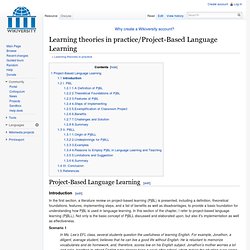
In this section of the chapter, I refer to project-based language learning (PjBLL). Not only is the basic concept of PjBLL discussed and elaborated upon, but also it's implementation as well as effectiveness. Scenario 1 In Ms. Search Results. Summary – Project Work in EFL Classrooms. CAELA: ESL Resources: Digests. Donna Moss, Arlington (VA) Education and Employment Program (REEP) Carol Van Duzer, National Center for ESL Literacy Education December 1998 Project-based learning is an instructional approach that contextualizes learning by presenting learners with problems to solve or products to develop.
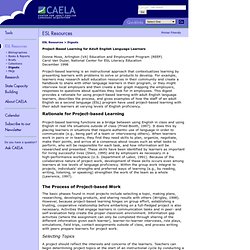
For example, learners may research adult education resources in their community and create a handbook to share with other language learners in their program, or they might interview local employers and then create a bar graph mapping the employers, responses to questions about qualities they look for in employees. This digest provides a rationale for using project-based learning with adult English language learners, describes the process, and gives examples of how the staff of an adult English as a second language (ESL) program have used project-based learning with their adult learners at varying levels of English proficiency. Rationale for Project-based Learning.